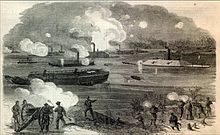Squib-class torpedo boat
 Design plans for Squib
| |
| Class overview | |
|---|---|
| Name | Squib class |
| Builders |
|
| Operators | |
| Built | 1863 - 64 |
| In commission | 1864–1865 |
| Planned | 15 |
| Completed | 4 |
| Cancelled | 11 |
| Lost | 4 |
| General characteristics | |
| Type | Torpedo boat |
| Length |
|
| Beam |
|
| Depth of hold | 3 feet 9 inches (1.14 m) |
| Propulsion |
|
| Complement | 5 or 6 |
| Armament | 1 × spar torpedo |
| Armor | Thin iron plates |
The Squib class torpedo boats were built for the
Description and construction
During the
The other three vessels of the class were longer than Squib and were very similar amongst themselves.
Squib was
Ships
| Ship | Laid down | Fate |
|---|---|---|
| Squib | 1863 | Scuttled February 1865, off Cape Fear |
| Scorpion | 1864 | Captured, January 24, 1865; possibly burned |
| Wasp | 1864 | Scuttled on night of April 2/3, 1865, near Richmond, Virginia |
| Hornet | 1864 | Sunk in collision, January 27, 1864 |
Squib
Squib was also known as Infanta.
Scorpion

Commanded by Lieutenant Edward Lakin,[18] Scorpion performed guard duty on the James River as part of the James River Squadron.[7] On the night of January 23, 1865, Scorpion participated in the Confederate offensive known as the Battle of Trent's Reach. When the Confederate vessels present reached Union obstructions at
Wasp
Wasp was commanded by
Hornet
Hornet was commanded by Master Samuel P. Blanc. On January 23 and 24, 1865, she also took part in the action at Trent's Reach.[6] After Scorpion ran aground, Hornet, who had been proceeding towards the ironclad CSS Richmond, encountered her and tried to get her unstuck, but was unable to do so due to the shallowness of the water. Hornet then moved upriver towards Battery Dantzler, arriving around the time of daylight. On January 27, Hornet collided with the steamer CSS Allison and sank.[25]
References
- ^ a b c d Pry & Zeitlin 1984, pp. 384–385.
- ^ a b Campbell 2000, p. 92.
- ^ a b c d Campbell 2000, p. 105.
- ^ Campbell 2000, p. 93.
- ^ a b c "Squib". Naval History and Heritage Command. Retrieved 27 February 2022.
- ^ a b "Hornet". Naval History and Heritage Command. Retrieved 27 February 2022.
- ^ a b c "Scorpion". Naval History and Heritage Command. Retrieved 27 February 2022.
- ^ a b c "Wasp". Naval History and Heritage Command. Retrieved 27 February 2022.
- ^ a b c d Silverstone 1989, p. 219.
- ^ a b c d Pry & Zeitlin 1984, p. 385.
- ^ Coski 2005, pp. 125–126.
- ^ a b Coski 2005, p. 126.
- ^ Campbell 2000, pp. 91–92.
- ^ Coski 2005, p. 125.
- ^ Coski 2005, pp. 218–219.
- ^ a b Pry & Zeitlin 1984, p. 387.
- ^ Campbell 2000, pp. 100, 102.
- ^ Campbell 2000, p. 111.
- ^ Coski 2005, pp. 198–202.
- ^ Coski 2005, pp. 201–203.
- ^ a b Coski 2005, p. 204.
- ^ Campbell 2000, p. 114.
- ^ Pry & Zeitlin 1984, p. 392.
- ^ Campbell 2000, p. 218.
- ^ Campbell 2000, pp. 114–115.
Sources
- Campbell, R. Thomas (2000). Hunters of the Night: Confederate Torpedo Boats in the War Between the States. Shippensburg, Pennsylvania: Burd Street Press. ISBN 1-57249-202-3.
- Coski, John M. (2005) [2006]. Capital Navy: The Men, Ships, and Operations of the James River Squadron. New York: Savas Beatie. ISBN 978-1-932714-15-9.
- Pry, Peter; Zeitlin, Richard (1984). "Torpedo Boats: Secret Weapons of the South". Warship International. 21 (4): 384–393. ISSN 0043-0374.
- Silverstone, Paul H. (1989). Warships of the Civil War Navies. Annapolis, Maryland: Naval Institute Press. ISBN 978-0-87021-783-8.
